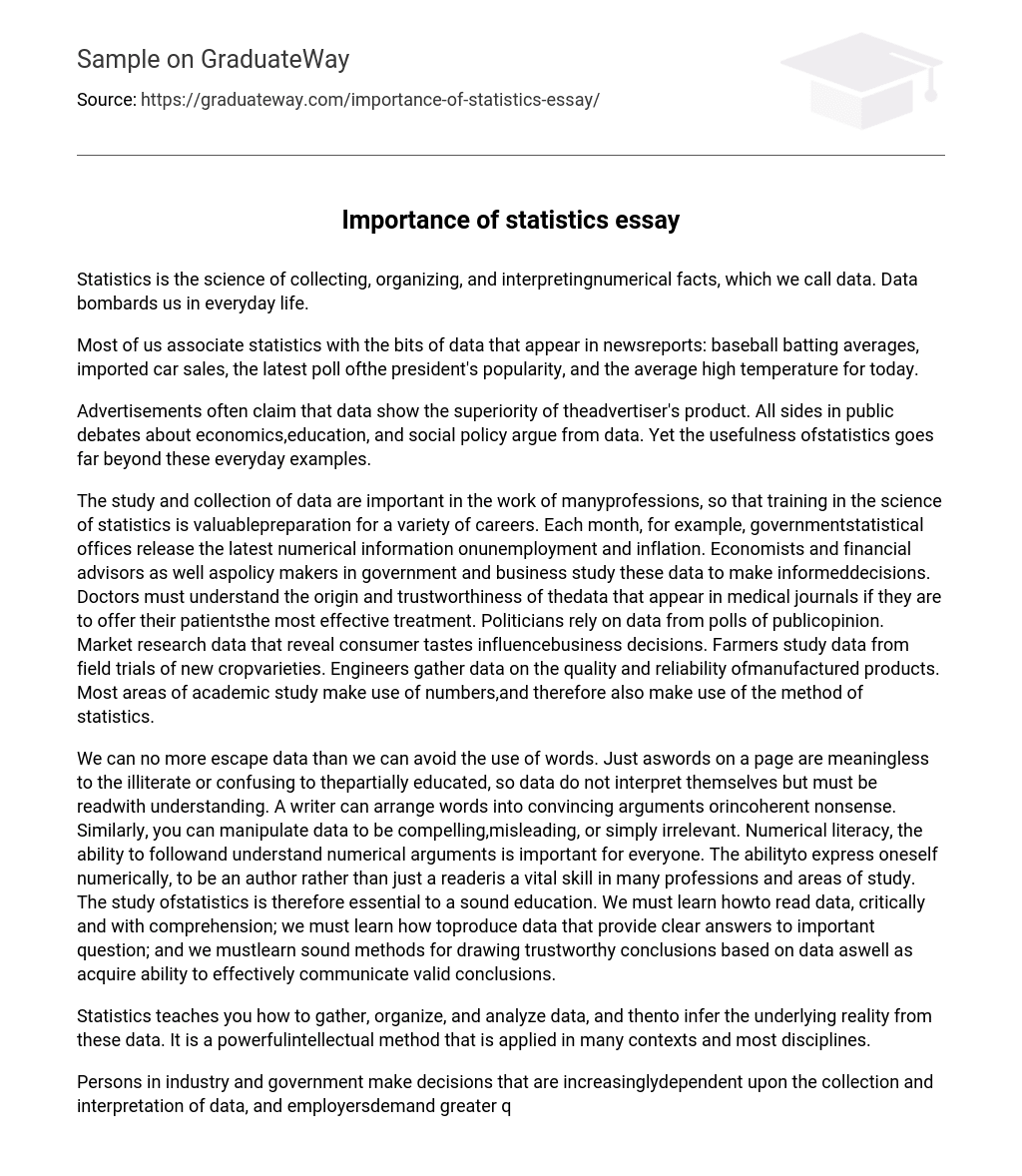Statistics is the science of collecting, organizing, and interpretingnumerical facts, which we call data. Data bombards us in everyday life.
Most of us associate statistics with the bits of data that appear in newsreports: baseball batting averages, imported car sales, the latest poll ofthe president’s popularity, and the average high temperature for today.
Advertisements often claim that data show the superiority of theadvertiser’s product. All sides in public debates about economics,education, and social policy argue from data. Yet the usefulness ofstatistics goes far beyond these everyday examples.
The study and collection of data are important in the work of manyprofessions, so that training in the science of statistics is valuablepreparation for a variety of careers. Each month, for example, governmentstatistical offices release the latest numerical information onunemployment and inflation. Economists and financial advisors as well aspolicy makers in government and business study these data to make informeddecisions. Doctors must understand the origin and trustworthiness of thedata that appear in medical journals if they are to offer their patientsthe most effective treatment. Politicians rely on data from polls of publicopinion. Market research data that reveal consumer tastes influencebusiness decisions. Farmers study data from field trials of new cropvarieties. Engineers gather data on the quality and reliability ofmanufactured products. Most areas of academic study make use of numbers,and therefore also make use of the method of statistics.
We can no more escape data than we can avoid the use of words. Just aswords on a page are meaningless to the illiterate or confusing to thepartially educated, so data do not interpret themselves but must be readwith understanding. A writer can arrange words into convincing arguments orincoherent nonsense. Similarly, you can manipulate data to be compelling,misleading, or simply irrelevant. Numerical literacy, the ability to followand understand numerical arguments is important for everyone. The abilityto express oneself numerically, to be an author rather than just a readeris a vital skill in many professions and areas of study. The study ofstatistics is therefore essential to a sound education. We must learn howto read data, critically and with comprehension; we must learn how toproduce data that provide clear answers to important question; and we mustlearn sound methods for drawing trustworthy conclusions based on data aswell as acquire ability to effectively communicate valid conclusions.
Statistics teaches you how to gather, organize, and analyze data, and thento infer the underlying reality from these data. It is a powerfulintellectual method that is applied in many contexts and most disciplines.
Persons in industry and government make decisions that are increasinglydependent upon the collection and interpretation of data, and employersdemand greater quantitative sophistication from their employees (orprospective employees). Indeed, in almost every aspect of our daily liveswe confront data and make judgments based on them, about issues rangingfrom airline safety to the spread of AIDS. It is now clear that theChallenger disaster never would have occurred if a statistically wiseperson had seen the data. This did not have to be a statistician, but one(say an engineer) with enough statistical literacy to see the strongrelationship between the temperature and the failure rate of the O-rings.
H.G. Wells anticipated that statistical thinking (numerical literacy) wouldone day be as necessary for efficient citizenship as the ability to readand write. Many individuals and professional groups think that day hascome. One individual has written that:”It is widely agreed that the critical reading and analysis of texts, themethodology of experimental science, and the deductive reasoning ofmathematics are broad intellectual methods that should be part of a generaleducation. It is now claimed by some that reasoning from numerical data –that is statistics — deserves a similar stature.”The influential National Science Board has suggested “elementary statisticsand probability should now be considered fundamental for all high schoolstudents.”Statistics students learn to define problems, to think critically, toanalyze and to synthesize which prepares them to explore widely throughouttheir professional lives, and to be creative and productive citizens –regardless of the precise nature of a career. They also learn to discoverthe integrity of data, the uncertainty of measurements and, through these,the development of understanding for the powers and limitations of science.
Moreover, students discover that there are things scientist can do andother things they cannot do and that experimental results are not exact butscientists can usually evaluate the range of uncertainty within specifiedconfidence limits (probabilities). The development of an understanding ofthe powers and limitations of science is essential to rationalparticipation in the resolution of societal issues.
The language of statistics is a foreign language to most students. It isnecessary for students to understand the language in order to understandthe concepts and the statistical procedures. Learning the language ofstatistics provides students with insights and an awareness of ideas andthoughts beyond the realm of previous experience. Statistical languagerequires precision and careful attention to exactly communicate validconclusions and interpretations, which result from data analysis.





